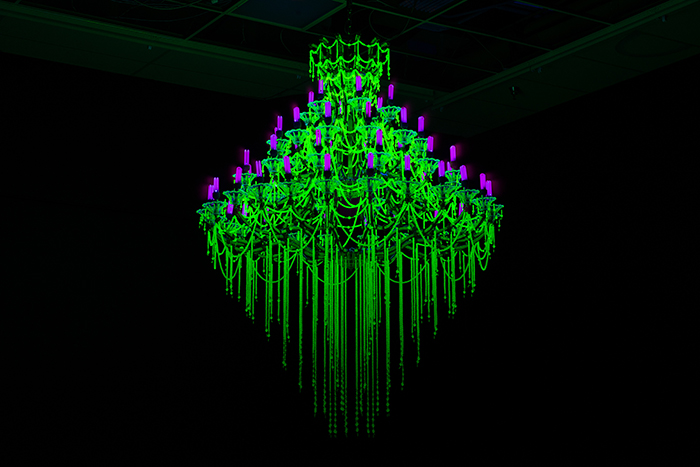News
Ken And Julia Yonetani’s Uranium Glass Chandeliers Banned From Shanghai Show


Chinese authorities have barred four sculptures from display at the Powerlong Art Museum in Qibao, Shanghai, according to a report by The Art Newspaper dated June 28. The works in question are uranium glass chandeliers by Japan-born, Australian artist duo Ken and Julia Yonetani, and were to be shown at the museum’s forthcoming exhibition, “Wavelength,” slated to open on July 8, 2018. Neither the museum nor the Chinese authorities have provided any explanation on the ban.
The works are part of the artists’ “Crystal Palace” series (2013), made in response to the environmental and social impacts of the Fukushima Daiichi nuclear disaster in 2011. The series comprises of 31 chandeliers, each representing a nation with nuclear power plants. The uranium glass beads turn fluorescent green—reminiscent of the bioluminescence of glow worms in Australian and New Zealand caves—as a result of the reaction between the UV light globes in the chandelier. The size of each work corresponds with that of the respective country’s nuclear industry, making the United States’s two-meter-high chandelier the largest among the collection.
For the Powerlong exhibition, the artists planned to submit their recently remade chandelier for China, as well as works representing North Korea, Hungary and Argentina, but were informed of the ban by the organizer of the exhibition, Cube Consulting Group in New York, weeks before the show.
The “Crystal Palace” series has been shown worldwide in previous exhibitions. The radiation levels in uranium glass are not sufficient to be harmful to human health, but countries that had raised safety concerns, such as France and Australia, requested expert testing ahead of the exhibitions, with all works subsequently cleared to be displayed publicly.
While the material is manufactured and sold across many countries, including the US and Japan, Chinese legislation prevents the private ownership and usage of all nuclear materials. However, the artists stated that Chinese authorities could have requested additional testing or documentation ahead of the exhibition, and that they “were quite amazed by the Chinese censorship.”
Mizuma Sueo, director of Mizuma Art Gallery, which represents the artist duo, told The Art Newspaper, “I believe the Shanghai municipal government forbade this work from being exhibited because it critiques the Chinese government’s nuclear power generation policies.”
Of the over 40 artists and collectives in “Wavelength,” Ken and Julia Yonetani are the only ones who have not been granted a permit.
Phoebe Tam is an editorial intern of ArtAsiaPacific.
To read more of ArtAsiaPacific’s articles, visit our Digital Library.







